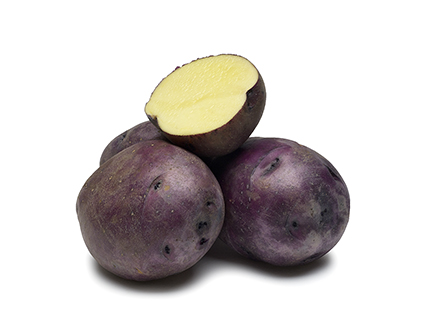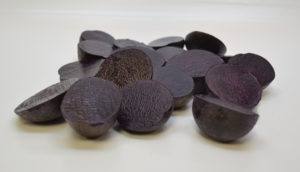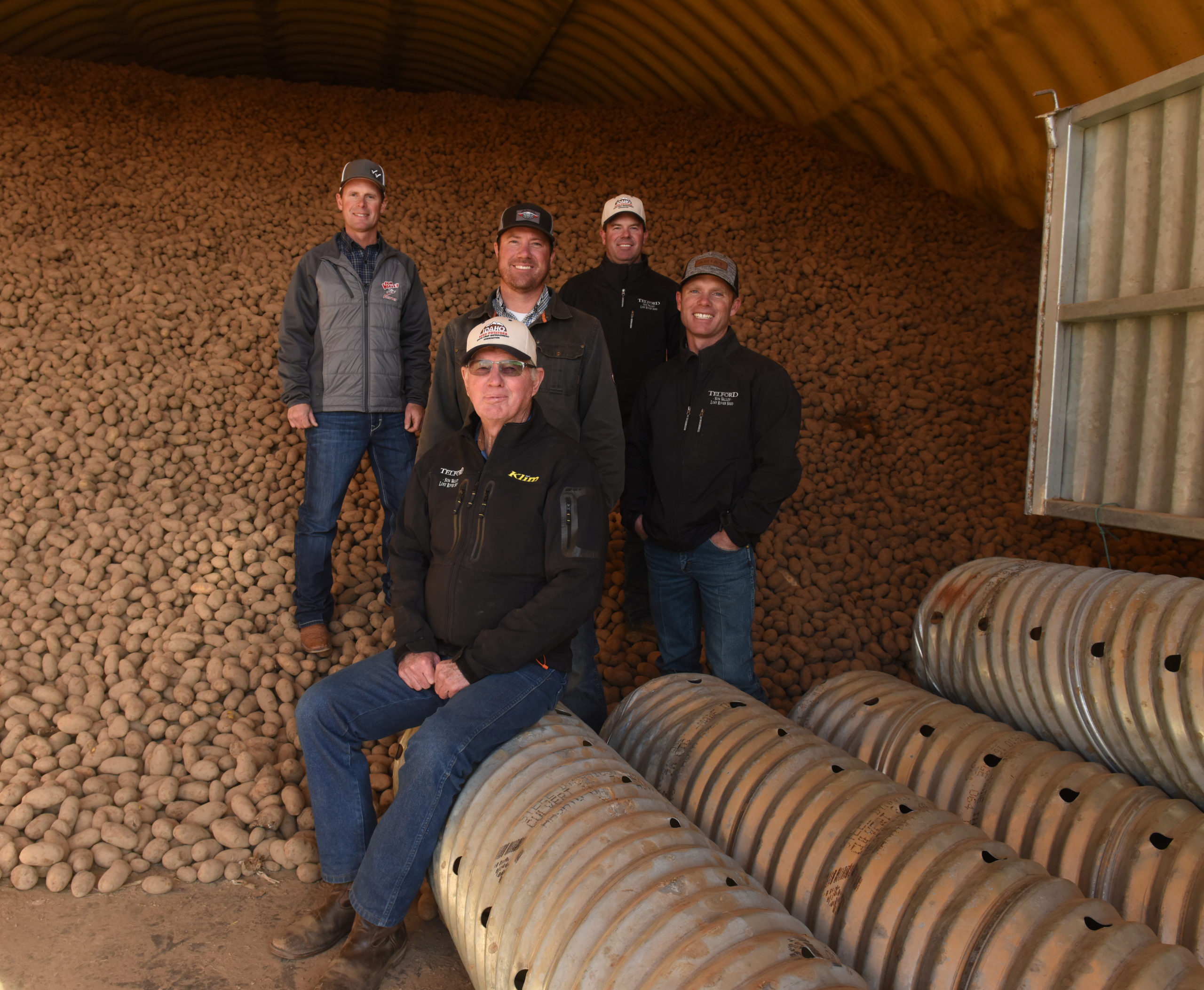
The rise of specialty potatoes
Specialty potatoes are distinctive from the standard potato varieties commonly found in the marketplace. They may have a unique skin color, such as deep purple or apricot or mottled colors, and the flesh color may be white, shades of red, purple or varying degrees of yellow or orange or a swirl or mixture of colors.

An older yellow flesh variety, the Yukon Gold, is considered a specialty potato in the U.S. because of its flesh color, but is standard fare in European homes. Fingerlings and red potatoes also classify as specialty. Examples include Red Pearl and Villetta Rose from the University of Wisconsin potato breeding program.
An important consideration in promoting any kind of potato — especially specialties — is to include a statement detailing the best uses for the potato being sold. This will be a big help to the consumer and is indeed an area that needs to be explored more fully if we are to maximize the specialty market.
The consuming public has become more perceptive and creative in how they choose their food. Consumers are demanding more choices in size, color, taste and packaging of fresh vegetables, potatoes included.
New specialty potato varieties are currently in high demand by restaurants and in an increasing number of large and small retail markets; and it appears that relatively high returns are possible with these varieties. Also, there have been many articles appearing in popular gardening publications and food sections in newspapers that have featured specialty potatoes, which has increased interest.
Once considered food for the poor, potatoes are currently quite fashionable and the fare of many an elegant dinner party. The dinner guests may be treated to golden nuggets of Yukon Gold surrounding a perfectly prepared entree or steamed slices of pretty pink Adirondack Red.
Challenges and opportunities
To develop greater consumer demand for these potatoes will require the same approach as for any new vegetable. It will take education of the consumer as to what the product is and how it can be use by them in their cooking and meal preparation.
It is important to have informational material available to the consumer near the display of specialty potatoes. I would suggest to start with a limited number of specialty potatoes displayed in the market. As the demand increases, one can then expand the number of varieties offered and increase the size of the display.
In the Andes Mountains in South America, home to the potato, one can find many hues of red, orange, brown, purple, blue and yellow among the twisted, knobby and smooth tubers of astonishing variations in shape and size. The display in the market of specialty potatoes can grow to include this wide diversity and may even come to rival the pepper display in terms of colors and shapes.

Red, white and blue potatoes have a strong patriotic ring and makes one feel like standing ramrod straight when peeling those potatoes for the traditional Fourth of July potato salad. Leaving the skins on would add some “1776” color to the potato salad and make it the envy of all the others at family get-togethers, not to mention all the gold ribbons one could garner at the local cook-offs and county fairs. Some of these potatoes, especially those with red and white skins and white flesh, make up a bulk of traditional tablestock potatoes sold. When you add the purple skin color, now you have moved into the specialty potatoes that certainly have potential in the fresh or tablestock market.
One could even develop a replica of the American Flag made from red, white and blue/purple skinned potatoes that could be used to introduce these potatoes to a new store. The nice thing about the potato varieties used in the flag is that they are all-purpose tablestock potatoes. The varieties we used were Dark Red Norland, Eva and Michigan Purple.
Another marketing approach we investigated was to make Penn State University potato salad using Adirondack Blue — bred by Ken Paddock of Cornell University — which has purple skin and flesh, with Eva or Michigan Purple for the white flesh. In fact, potatoes are available to create a potato salad for most school colors, with the possible except of green. (Sorry, Michigan State fans.)
Colorful chips
Chip companies have begun using potatoes with different internal color, such as blue or really purple for chips in mixed packs.
Utz Quality Foods has its “Natural Gourmet Medley Kettle Cooked Potato Chips” that has a purple potato chip in the mixture.
Terra Chips has been marketing purple potato chips such as their Sweets and Blues, which are both purple potatoes and sweet potato chips. The purple-fleshed potato used is probably David Holm’s (Colorado State University) Purple Majesty that has been the go-to purple skinned/purple flesh line.
Another company is Jackson’s Honest out in Colorado sells Purple Heirloom potato chips slow cooked in coconut oil, again using Purple Majesty.
I have always thought that potato chips were the way to really use specialty potatoes so throughout my career at Penn State University I experimented and trialed numerous specialty potatoes and worked with colleagues in the Penn State Center for Food Innovation, the Food Science Department and the College of Health and Human Development developing different uses for specialty potatoes.
When I retired, Ben Nason, a former student, caught the vision of what I was trying to do and along with another colleague Tom Laird, a graphic artist, started Tailgater Taters LLC to make blue (actually purple) and white chips marketed in 2-ounce bags for the Penn State marketplace and sporting activities. We have used both Purple Majesty and a new purple-skin and purple-flesh variety called Blackberry developed by Douches and his breeding team at Michigan State.
A word of caution about chipping these varieties is that they are tablestock varieties — not chippers — and the specific gravities are lower than regular chip varieties, so temperatures during storage are critical so as to be able to chip them without having them brown.
I always believed that you could market colored chips easier than marketing the raw colored fleshed potato for potato salad or mashed potatoes. People’s eyes seem to tell their brain that maybe this is not something that should be eaten. This would be like your eyes telling your brain that green catsup on your hot dog is not that appealing.
You also can do colored fries, as we have use yellow fleshed varieties for years but you could add deep purple or red colored fleshed potatoes to the mix. Again, remember to use caution with storage temperatures.
Packaging of specialty potato varieties is important since consumers buy on eye appeal. Packages should contain 3 to 5 pounds of small, uniform tubers that are free from blemishes and should emphasize tuber size and color. The Patriotic Packs of red, white and blue potatoes for the Four of July will only be as good as the production and handling. Another good idea is to use small wooden baskets to market the potatoes at roadside or farmer’s markets.
Conclusion

Specialty potatoes can be successfully produced in conventional field production or grown using plastic mulch and drip irrigation in the field or high tunnels for both early- and late-season production. High tunnels can produce several crops a year and using a variety like Blackberry, for example. We were able to have a nice crop of dark purple skin and flesh colored potatoes in 77 to 87 days. High tunnels may have the potential for three potato crops a year.
The future will bring more interesting specialty varieties from breeders like Douches, DeJong and Holm, as well as Mark Clough (North Carolina State) and Greg Porter (University of Maine).
It is indeed a team effort to really increase the use of specialty potatoes whether in the fresh marketplace or the processing marketplace. I have enjoyed working with all these folks over the years and look forward to continuing to work with them in the future.
Finally, the specialty potatoes of today are definitely not the potatoes that my grandfather and great grandfather grew in County Tyrone in Northern Ireland at the turn of the last century.
— William Lamont Jr. is Emeritus Professor of Vegetable Crops at Penn State University’s Department of Plant Science. He holds a Ph.D. in vegetable crops from Cornell University.
Top photo — Huckleberry Gold potatoes







